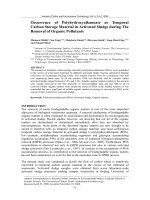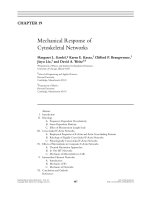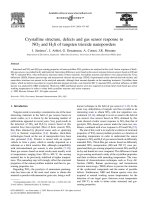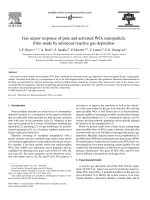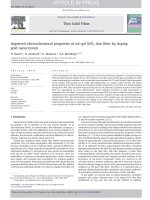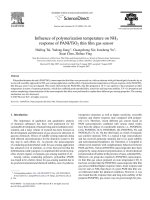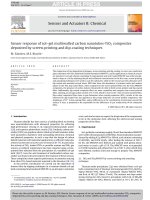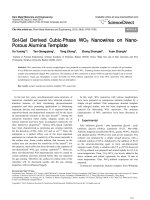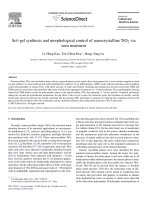- Trang chủ >>
- Khoa Học Tự Nhiên >>
- Vật lý
sensor response of sol–gel multiwalled carbon nanotubes-tio2 composites
Bạn đang xem bản rút gọn của tài liệu. Xem và tải ngay bản đầy đủ của tài liệu tại đây (1.03 MB, 7 trang )
Please cite this article in press as: M. Sánchez, M.E. Rincón, Sensor response of sol–gel multiwalled carbon nanotubes-TiO
2
composites
deposited by screen-printing and dip-coating techniques, Sens. Actuators B: Chem. (2009), doi:10.1016/j.snb.2009.04.006
ARTICLE IN PRESS
G Model
SNB-11472; No. of Pages 7
Sensors and Actuators B xxx (2009) xxx–xxx
Contents lists available at ScienceDirect
Sensors and Actuators B: Chemical
journal homepage: www.elsevier.com/locate/snb
Sensor response of sol–gel multiwalled carbon nanotubes-TiO
2
composites
deposited by screen-printing and dip-coating techniques
M. Sánchez, M.E. Rincón
∗
Centro de Investigación en Energía, Universidad Nacional Autónoma de México, Apartado Postal 34, Temixco 62580, MOR, Mexico
article info
Article history:
Received 26 June 2008
Received in revised form 21 February 2009
Accepted 6 April 2009
Available online xxx
Keywords:
TiO
2
Multiwalled carbon nanotubes
Screen-printing
Dipping
Sensors
abstract
The comparison of two deposition techniques, screen-printing and dip-coating, to cover non-conductive
glass substrates with TiO
2
:Multiwall Carbon Nanotubes (MWCNT), and its application as chemical sensors
are reported. A sol–gel solution containing Ti-isopropoxide and acid treated MWCNT was either precipi-
tated or kept as a sol by adjusting the pH and surfactant concentration. In the first case, screen-printing
and annealing techniques were used to coat the substrates, while in the second case the substrates were
dip coated and anneale d several times. XRD data show the abundance of oriented rutile and anatase
planes in the TiO
2
dip-coated films, when compared to the screen-printed films. For the TiO
2
:MWCNT
composites, the presence of carbon induces the growth of rutile in both screen-printed and dip-coated
films. Additionally, dip-coated composite films are more crystalline and compact than screen-printed
films, showing an average carbon content of 5–7 wt%, which is close to the 7 wt% of screen-printed films.
Dip-coated composite films show n-type behaviour when sensing ammonia (NH
3
), similar to the one
observed for dip-coated TiO
2
but opposite to the p-type behaviour of screen-printed composites. The
abundance of Ti
3+
in dip-coating films, and/or differences in the coordination environment around the
surface Ti sites, is proposed to be responsible for the differences in p/n conductivity of the composite
films.
© 2009 Elsevier B.V. All rights reserved.
1. Introduction
Titanium dioxide has been used as a building block to develop
new nanoarchitectures with advanced properties for achieving
high-performance sensing [1–4], improved photocatalytic power
[5,6], and superior photovoltaic results [7,8]. Similarly, carbon nan-
otubes (CNTs) are graphene sheets rolled up to build seamless tubes
with nanometric diameters with outstanding electronic, chemical
and physical properties, in such a way that the design of carbon
hybrid materials with potential applications as efficient molecular
sensors has become an active area of research [9–17]. In particular,
the activity of TiO
2
loaded CNTs as possible acetone and NH
3
gas
sensors at ambient temperature has been reported using screen-
printed films obtained from the precipitates of a modified sol–gel
bath [16,17]; here the acid treatment of multiwalled carbon nan-
otubes was found critical to improve the response of these sensors.
These composites show superior performance in ammonia sensing
than other TiO
2
based materials reported in the literature [18–21].
In the present contribution we carried out the deposition of
thinner films by dipping techniques in a titanium dioxide sol–gel
bath containing functionalized MWCNT, in an attempt to minimize
∗
Corresponding author. Tel.: +52 555 6229748; fax: +52 777 3250018.
E-mail address: (M.E. Rincón).
costs, and also because we expect the dispersion of the components
to be at the molecular level, affecting the electrical and sensing
properties of the films.
2. Experimental
Sol–gel baths containing roughly 10 wt% functionalized MWCNT
were used in the preparationof the films. Functionalization was per-
formed by adding 0.5 g MWCNT to 100 mL acid solution containing
2.5 M HNO
3
and 0.5 M H
2
SO
4.
After boiling the mixture at 100
◦
C
for 6 h, the MWCNT were filtered and washed with plenty deion-
ized water to reach a pH of 7.0. The MWCNT were re-suspended
in 3 M HCl solution and refluxed for 5 h at 100
◦
C, after which they
were filtered, washed, dried and storage to prepare TiO
2
:MWCNT
composites.
2.1. TiO
2
and TiO
2
/MWCNT by screen-printing and annealing
techniques
Titanium oxide precipitates (2 g) were obtained from a sol–gel
bath containing 8 mL of titanium tetraisopropoxide [Ti(C
3
H
6
OH)
4
,
Sigma–Aldrich 97%], 84 mL of 2-propanol (Sigma–Aldrich 99%),
and 8 mL of HCl (J.T. Baker 37 wt%). The mixture was kept under
strong stirring for 24 h, forced to precipitate with 3 mL of NH
4
OH
(Sigma–Aldrich 28–30%), filtered, and dried at 70
◦
C for 24 h. To
0925-4005/$ – see front matter © 2009 Elsevier B.V. All rights reserved.
doi:10.1016/j.snb.2009.04.006
Please cite this article in press as: M. Sánchez, M.E. Rincón, Sensor response of sol–gel multiwalled carbon nanotubes-TiO
2
composites
deposited by screen-printing and dip-coating techniques, Sens. Actuators B: Chem. (2009), doi:10.1016/j.snb.2009.04.006
ARTICLE IN PRESS
G Model
SNB-11472; No. of Pages 7
2 M. Sánchez, M.E. Rincón / Sensors and Actuators B xxx (2009) xxx–xxx
obtain 1 g of TiO
2
–MWCNT composite with 10 wt% MWCNT, 0.1 g
of previously functionalized MWCNT were added to 42 mL iso-
propanol and ultrasonicated for 30 min (Aquasonic 250D, VWR
Scientific Products). The MWCNT solution was acidified with 4 mL
of concentrated HCl, and 4 mL of titanium isopropoxide were added
drop by drop under strong stirring. After 24 h, the solvent was
evaporated at 70
◦
C for another 24 h; this precipitate was labelled
TiO
2
/MWCNT. For film deposition, the precipitates were annealed
in air at 400
◦
C for 1 h, after which a small amount (0.5 g) of
TiO
2
/MWCNT powder was mixed with 4–6 drops of Triton-X to
obtain the screen-printing paste. In the case of TiO
2
powder
,
0.5 g
were mixed with 10–20 drops of propylene glycol to obtain the
paste. Corning glass substrates (1
× 3
) were thoroughly washed
and used as substrates for screen-printed coatings. The films were
annealed at 40 0
◦
C in air for 1 h to eliminate the organic com-
pounds.
2.2. TiO
2
and TiO
2
–MWCNT by dip-coating and annealing
techniques
TiO
2
and TiO
2
–MWCNT composites thin films were prepared
by the sol–gel dip-coating method using compositions similar to
the ones described in Section 2.1, except for the lower amount of
HCl (0.025 mL) used to facilitate titania deposition. Corning glass
substrates were dipped into the solution and withdrawn at a con-
stant rate of 30 mm/min, annealing at 400
◦
C for 5 min af ter each
dipping-withdrawing process. Notice that composites obtained by
the precipitation method and used in screen-printed films are
labelled (TiO
2
/MWCNT), while composites deposited from solu-
tion by the dip-coating technique are labelled (TiO
2
–MWCNT).
The dip-coated films reported here were subjected to 15 dipping-
withdrawing-annealing cycles, before being sintered at 400
◦
Cfor
30 min as the final step.
2.3. Characterization
The optical transmittance and specular reflectance of the films
were measured in the wavelength interval of 0.2–1 m in a Shi-
madzu UV1601 spectrophotometer using either air (transmittance)
or aluminium mirrors (specular reflectance) as reference. The crys-
talline structure of TiO
2
:MWCNT composites was investigated by
X-ray diffraction (XRD) analysis performed using a Rigaku Dmax
2200 equipment with Cu K␣ ( = 0.15405 nm) radiation. Crystal-
lite size was calculated from Debye-Scherrer equation [22], using
the most intense peak at 2Â =25
◦
. Thermogravimetry analysis were
carried out in a TA Instruments Q500 analyzer in 40 sccm/min oxy-
gen flow from room temperature to 1000
◦
C with 20
◦
C/min ramp.
Attenuated Transmission Reflectance (ATR) infrared studies were
performed with a diamond crystal in the range of 4000–600 cm
−1
by using a Perkin-Elmer Spectrum GX spectrometer. Film thickness
was measured by an Alpha Step perfilometer (Tencor Instruments).
Sensing was performed in a home made system described else-
where [20,21]; basically, electrical contacts made with silver paint
were draw as parallel lines with 1 cm length and 1 cm separation to
obtain a square configuration. A 6487 Keithley multimeter/voltage
source unit was used to apply 1–10 V and to monitor changes in
film’s sheet resistance (R
s
) during exposure to NH
3
. Experiments
were conducted under ambient conditions (atmospheric pressure
and 27
◦
C), and at a 1% NH
3
concentration in 150 mL/min nitrogen
flow. An experimental trial started with R
s
being measured in air at
ambient conditions and then a flow of ammonia containing nitro-
gen was introduced to the chamber for 5–10 min. After measuring
R
s
in the presence of ammonia, the chamber was opened to air to
recover the baseline under static conditions to emulate operation
under real situations (i.e., most sensing studies flush the sample
chamber with the carrier gas before and after sensing to recover
the baseline). A measuring cycle consisted of the time required to
monitor the changes in resistance due to ammonia adsorption, and
the time required to recover the baseline. There was a few min-
utes break between cycles, and for a typical run, 5 cycles were
run with good reproducibility. To measure the photoresponse of
these films at 10 V polarization, a 20 W UV lamp (Model ES20MBLB
from Lumiaction, Wavelength: 365 nm) was used, keeping the films
in darkness for 5 min, followed by 5 min illumination, and 20 min
darkness to reach equilibrium. The spectral response was measured
with a 300 W tungsten lamp combined with a monochromator
(Spectra Physics: Cornerstone Model 74100), a multimeter (Kei-
htley 236), and a PCL812PG card for irradiance measurement. All
measurements were done at ambient conditions.
3. Results
3.1. Materials characterization
Fig. 1 shows the images of some of the films obtained with both
deposition techniques. Coatings fabricated by screen-printing are
depicted in Fig. 1(a), while coatings obtained by the dipping tech-
nique are shown in Fig. 1(b). It is clear the difference in thickness
and reflectivity of the TiO
2
films obtained by the two deposi-
tion methods; in general, the screen-printed films are thicker,
opaque, and with poor adherence. Table 1 summarizes the thick-
ness and resistivity of the obtained films, and Fig. 2 illustrates the
changes in optical transmittance and specular reflectance. In both
deposition techniques, the presence of MWCNT decreases the trans-
mittance and specular reflectance notably. Moreover, the specular
reflectance of dip-coated TiO
2
films is substantially higher than
the one observed in screen-printed TiO
2
films, but is about the
Fig. 1. Photographs of: (a) screen printed TiO
2
films (left) and TiO
2
/MWCNT com-
posites (rigth); (b) dip-coated TiO
2
films (left) and TiO
2
–MWCNT composites (right).
Please cite this article in press as: M. Sánchez, M.E. Rincón, Sensor response of sol–gel multiwalled carbon nanotubes-TiO
2
composites
deposited by screen-printing and dip-coating techniques, Sens. Actuators B: Chem. (2009), doi:10.1016/j.snb.2009.04.006
ARTICLE IN PRESS
G Model
SNB-11472; No. of Pages 7
M. Sánchez, M.E. Rincón / Sensors and Actuators B xxx (2009) xxx–xxx 3
Table 1
Thickness and resistivity of screen printed and dip-coated films measured at atmo-
spheric pressure and 27
◦
C.
Film Thickness (m) Resistivity ( cm)
Screen-printed TiO
2
1.5 3.0 × 10
6
Screen-printed TiO
2
/CNT 2.0 4.0 × 10
1
Dip-coated TiO
2
0.5 1.0 × 10
6
Dip-coated TiO
2
-CNT 1.6 1.6 × 10
4
same (close to 2 wt%) in TiO
2
/MWCNT and TiO
2
–MWCNTcomposite
films.
Fig. 3 presents the XRD patterns of TiO
2
and TiO
2
:MWCNT com-
posite films obtained by screen-printing (Fig. 3a) and dip-coating
(Fig. 3b). XRD data of MWCNT powders before and after functional-
ization are also shown to aid to the identification of small changes
in the patterns of the composite films; the narrower and more sym-
metric shape of the MWCNT peak at 2Â =26
◦
indicates the lost of
amorphous carbon after functionalization. XRD patterns of screen-
printed TiO
2
films show anatase as the main phase, accompanied
by small peaks of rutile and brookite. This TiO
2
pattern is slightly
modified when MWCNT are added to the sol–gel bath and fast pre-
cipitation is induced through solvent evaporation. Fig. 3(a) shows
a reduced intensity in the diffraction of brookite at 2Â =33
◦
and
enhanced intensity in the rutile peak at 2Â =27
◦
. On the other hand,
films obtained by dip-coating show the absence of brookite phase,
sharper diffraction peaks, and obvious differences between TiO
2
and TiO
2
–MWCNT films. By comparing the diffractions at 2Â =38
◦
,
54
◦
,63
◦
in Fig. 3(b), it is clear the lost of preferential growth in
anatase planes, and the induced crystalline growth of rutile phase
Fig. 2. Optical properties of: (a) dip-coated films, (b) screen-printed films. TiO
2
(broken line), TiO
2
:MWCNT (solid line). Inset: TiO
2
(1), TiO
2
–MWCNT (2).
in the XRD patterns of TiO
2
–MWCNT films. For screen printed films,
crystallite sizes were 8–10 nm, while for dip-coated films they were
25–28 nm.
The degree of MWCNT functionalization and its interaction with
TiO
2
can be obtained from the ATR infrared spectra of Fig. 4. Absorp-
tion bands corresponding to carbonyl (1640 and 1660 cm
−1
), as
well as lower intensity peaks due to sulfonic groups (1050 and
1170 cm
−1
), are observed in the acid treated MWCNT. No new peaks
are evident when the functionalized carbon interacts with TiO
2
in
the sol–gel bath, though the peak at 1660 cm
−1
is slightly shifted
to higher numbers (1770 cm
−1
) and the absorptions at 1050 and
1170 cm
−1
become broader. The broadening suggests the presence
of a new band at 1163 cm
−1
, which can be related to the formation
of esters or Ti-O-O-C bonds.
3.2. Room temperature sensing
The sensor performance of sol–gel multiwalled carbon
nanotubes-titania composites deposited by screen-printing and
dip-coating techniques is summarized in Table 2. Sensor response
(SR) corresponds to the ratio [(R
NH
3
− R
air
)/R
air
] × 100, response
time (t
r
) the time required for reaching 90% of the final resis-
tance, and desorption time (t
d
) the time required to recover the
baseline (i.e., R
air
). The changes in sheet resistance of TiO
2
films
exposed to NH
3
are shown in Fig. 5; comparable values are obtained
for TiO
2
screen-printed films (Fig. 5a) and TiO
2
dip-coating films
(Fig. 5b) regardless of their different thickness. Both TiO
2
films
show a decrease in resistance upon ammonia adsorption, which
is typical of n-type semiconducting films in the presence of elec-
tron donor molecules. In this figure the concentration of ammonia
is represented by the dashed line. The response of MWCNT and
composite films is presented in Fig. 6. Carbon nanotubes show an
increased resistance upon ammonia adsorption (Fig. 6a) which is
typical of p-type semiconductors in the presence of a reducing gas
(i.e., holes undergo recombination with the electrons donated by
ammonia). Similar behaviour is observed in composites obtained by
screen-printing techniques but not on composites obtained by dip-
coating, where the resistance decreases upon ammonia adsorption.
Additionally, R
s
differences between screen-printed and dip-coated
composites (in the order of 10
4
) are surprising and cannot be
accounted by thickness differences.
To get additional information about possible factors causing dis-
similar sensor response in composite films, the amount of CNT
incorporated in the titania matrix was determined by TGA, and
both composite report between 5 and 7 wt% carbon content. To
rule out the possibility of carbon segregation in dip-coated films
(i.e., percolation problems), their photoresponse was taken at room
temperature and atmospheric pressure (air). Fig. 7 shows a large
decrease (three orders of magnitude) in sheet resistance upon
illumination, and similar values between illuminated TiO
2
and
TiO
2
–MWCNT measured in the dark. The longer recovery time
observed in TiO
2
–MWCNT films after illumination suggests the
abundance of surface states, and agrees with the larger photocur-
rent ratio I
TiO
2
-MWCNT
/I
TIO
2
observed in Fig. 8 at large wavelength
(i.e., sensitization by surface states).
Table 2
Behaviour-type, sensor response, and times of adsorption/desorption of screen-
printed and dip-coated films sensing a flux of 150 mL of N
2
with a charge of 1%
NH
3
.
Material Behavior-type SR (%) t
r
(min) t
d
(min)
Screen-printed CNT as-prepared p 6.5 6 ∞
Screen-printed TiO
2
n9751
Screen-printed TiO
2
/CNT p 8 2 7
Dip-coated TiO
2
n98122
Dip-coated TiO
2
-CNT n 93 9 2
Please cite this article in press as: M. Sánchez, M.E. Rincón, Sensor response of sol–gel multiwalled carbon nanotubes-TiO
2
composites
deposited by screen-printing and dip-coating techniques, Sens. Actuators B: Chem. (2009), doi:10.1016/j.snb.2009.04.006
ARTICLE IN PRESS
G Model
SNB-11472; No. of Pages 7
4 M. Sánchez, M.E. Rincón / Sensors and Actuators B xxx (2009) xxx–xxx
Fig. 3. X-ray diffraction of: (a) screen-printed films, (b) dip-coated films. (1) As received MWCNT, (2) acid treated MWCNT, (3) TiO
2
, (4) TiO
2
:MWCNT. CNT/Multiwall carbon
nanotubes; A, anatase; B, brookite; R, rutile.
4. Discussion
As explained in Section 2, films obtained by dip-coating and
screen-printing techniques differ in the volume of HCl used in
the sol–gel bath, as well as in the multiple annealing steps of the
Fig. 4. Attenuated transmittance reflectance studies of screen printed powders: TiO
2
(1), as received MWCNT (2), acid treated MWCNT (3), TiO
2
/MWCNT (4).
dip-coating method that allow for a more compact and crystalline
layer of the dip-coated materials. Dip-coated films show the abun-
dance of rutile phase especially when functionalized MWCNT were
present, and could be related to the fast colloidal growth/deposition
in high pH baths. These films increase its mass when annealed
in oxygen above 400
◦
C, in clear contrast with screen-printed
films. The mass increment suggests further oxidation of Ti
3+/2+
states, in accordance with previous XPS studies of sol–gel TiO
2
thin films where the abundance of Ti
3+
and Ti
2+
was observed in
films annealed below 600
◦
C [23–25]. The presence of Ti
3+
sites
might be related to the longer recovery time of TiO
2
–MWCNT
films after illumination, and to the de-doping of MWCNT in dip-
coated composites, given the large tendency of Ti
3+
sites to trap
holes. De-doping of MWCNT explains the large dif ference in resis-
tance b etween the composites, in view of the fact that a large
decrease in resistivity upon illumination (observed in dip-coated
TiO
2
–MWCNT, but not in screen-printed composites) supports a
low concentration of majority carriers (observed under dark con-
ditions) rather than a large inter-particle resistance that will also
block charge transport of the carriers produce under illumination.
Regarding the sensing mechanism, the type of adsorption (weak
or strong) is correlated with the amount of charge transferred, the
stability of the species before and after adsorption, and the pres-
ence of adsorption/desorption barriers. In the mechanism proposed
in Fig. 9, we tried to correlate the differences in microstructure
and stoichiometry of the dip-coated and screen-printed compos-
ites with their sensing performance. The color and size of titania
symbols are representative of the lack (white) or abundance (yel-
low) of Ti
3+
states and of the crystallite size obtained by XRD;
the size of the arrows illustrate the magnitude of charge transfer.
Please cite this article in press as: M. Sánchez, M.E. Rincón, Sensor response of sol–gel multiwalled carbon nanotubes-TiO
2
composites
deposited by screen-printing and dip-coating techniques, Sens. Actuators B: Chem. (2009), doi:10.1016/j.snb.2009.04.006
ARTICLE IN PRESS
G Model
SNB-11472; No. of Pages 7
M. Sánchez, M.E. Rincón / Sensors and Actuators B xxx (2009) xxx–xxx 5
Fig. 5. Curves of TiO
2
sheet resistance vs. time: (a) screen-printed films, (b) dip-
coated films. Coatings exposed to 150 mL N
2
flow with vol.% NH
3
as indicated by the
broken line.
Fig. 6. Curves of sheet resistance vs. time: (a) as received MWCNT films, (b) screen
printed TiO
2
/MWCNT films, (c) dip-coated TiO
2
–MWCNT films. Coatings exposed to
150 mL N
2
flow with vol.% NH
3
as indicated by the broken line.
Fig. 7. Photoresponse of dip-coated films in UV light: TiO
2
(broken line),
TiO
2
–MWCNT (solid line).
For dip-coated composite films, where R
s
decreases upon ammo-
nia adsorption and the recovery time is small, our hypothesis is
that the abundance Ti
3+
(or MWCNT de-doping) is indicative of
the strong interaction between MWCNTs and titania, causing a
weak interaction towards NH
3
. Moreover, NH
3
detection takes place
mainly through the inter-tube modulation ef fect (i.e., the pres-
ence of an electric field at the interface of MWCNT-TiO
2
-MWCNT
particles) with titania acting as a buffer layer to avoid further MWC-
NTs de-doping. For screen-printed TiO
2
/MWCNT films, the sensing
mechanism seems to be determined by the strong interaction of
NH
3
with MWCNT given its poor intimate contact with titania par-
ticles. Previous theoretical work with acetone adsorption [21], and
current experimental and theoretical calculations with titania films
annealed at different temperatures, made clear the importance
and relevance of the precise details on the coordination environ-
ment around the Ti sites. It determines the weak/strong interaction
between titania and MWCNT, as well as the reversibility of ammo-
nia adsorption/desorption, and the direction and amount of charge
transfer.
Fig. 8. Photocurrent ratio of dip-coated TiO
2
–MWCNT films and TiO
2
films as a func-
tion of wavelenght. The spectral response of TiO
2
(broken line) and TiO
2
–MWCNT
(solid line) are shown in the inset.
Please cite this article in press as: M. Sánchez, M.E. Rincón, Sensor response of sol–gel multiwalled carbon nanotubes-TiO
2
composites
deposited by screen-printing and dip-coating techniques, Sens. Actuators B: Chem. (2009), doi:10.1016/j.snb.2009.04.006
ARTICLE IN PRESS
G Model
SNB-11472; No. of Pages 7
6 M. Sánchez, M.E. Rincón / Sensors and Actuators B xxx (2009) xxx–xxx
Fig. 9. Schematic of the sensing mechanisms proposed for: (a) dip-coated films (strong interaction between MWCNT and TiO
2
); (b) screen-printed films (weak interaction
between CNT and TiO
2
). Gray symbols represent functionalized CNTs. Titania symbols illustrates the lack (white symbols) or abundance (yellow symbols) of Ti
3+
states. The
size of titania particles are representative of crystallite size, and the arrow size illustrates the amount of charge transferred.
5. Conclusion
The comparison of two deposition techniques, screen-printing
and dip-coating, to obtain TiO
2
:MWCNT sensors is reported.
A sol–gel solution containing Ti-isopropoxide and acid treated
MWCNT was either precipitated or kept as a sol by adjusting the
pH and surfactant concentration. In the first case, screen-printing
and annealing techniques were used to coat the substrates, while
in the second case the substrates were dip-coated and annealed
several times to obtain the films. XRD data show the abundance of
oriented rutile and anatase planes in dip-coated films, when com-
pared to screen-printed films. Dip-coated composite films show
n-type behaviour when sensing ammonia (NH
3
), similar to the one
observed for dip-coated TiO
2
but opposite to the p-type behaviour
of screen-printed composites. The abundance of Ti
3+
in dip-coating
films, and/or differences in the coordination environment around
the surface Ti sites, is proposed to be responsible for the differ-
ences in p/n conductivity of the composite films, in accordance with
previous theoretical results.
Acknowledgments
Financial support from DGAPA-UNAM (IN11110 6-3), PUNTA-
UNAM, CONACYT-México (49100), are gratefully acknowledged, as
well as the fellowship (M. Sánchez) provided by CONACYT-México.
We thank R. Morán and M.L. Román for technical assistance and
XRD analyses.
References
[1] L. Yadav, N.C. Gupta, R. Dwivedi, R.S. Singh, Sensing behaviour and mechanism
of titanium dioxide-based MOS hydrogen sensor, Microelectron. J. 38 (2007)
1226–1232.
[2] M.R. Mohammadi, D.J. Fray, M. Ghorbani, Comparison of single and binary
oxide sol–gel gas sensors based on titania, Sol. State Sci. 10 (2008)
884–893.
[3] J. Tan, W. Wlodarski, K. Kalantar-Zadeh, Nitrogen dioxide gas sensors based on
titanium dioxide thin films deposited on langasite, Thin Solid films 515 (2007)
8738–8743.
[4] A. Teleki, S.E. Pratsinis, K. Kalyanasundaram, P.I. Gouma, Sensing of organic
vapors by flame-made TiO
2
nanoparticles, Sens. Actuators B Chem. 119 (2006)
683–690.
[5] K.S. Raja, M. Misra, V.K. Mahajan, T. Gandhi, P. Pillai, S.K. Mohapatra, Photo-
electrochemical hydrogen generation using band-gap modified nanotubular
titanium oxide in solar light, J. Power Sources 161 (2006) 1450–1457.
[6] Y.F. Su, Y.C. Weng, T.C. Choua, Templateless nanofiber photoelectrode pre-
pared using mild hydrothermal conditions, J. Electrochem. Soc. 155 (2) (2008)
K23–K29.
[7] K. Shankar, G.K. Mor, M. Paulose, O.K. Varghese, C.A. Grimes, Effect of
device geometry on the performance of TiO
2
nanotube array-organic semi-
conductor double heterojunction solar cells, J. Non-Cryst. Sol. 354 (2008)
2767–2771.
[8] A. Kongkanand, K. Tvrdy, K. Takechi, M. Kuno, P.V. Kamat, Quantum dot solar
cells. Tuning photoresponse through size and shape control of CdSe-TiO
2
archi-
tecture, J. Am. Chem. Soc. 130 (2008) 4007–4015.
[9] H.L. Hsu, J.M. Jehng, Y. Sung, L.C. Wang, S.R. Yang, The synthesis, characterization
of oxidized multi-walled carbon nanotubes, and application to surface acoustic
wave quartz crystal gas sensor, Mat. Chem. Phys. 109 (2008) 148–155.
[10] M.K. Kumar, A.L.M. Reddy, S. Ramaprabhu, Exfoliated single-walled carbon
nanotube-based hydrogensensor, Sens. Actuators B Chem. 130 (2008) 653–6 60.
[11] S. Sivaramakrishnan, R. Rajamani, C.S. Smith, K.A. McGee, K.R. Mann, N.
Yamashita, Carbon nanotube-coated surface acoustic wave sensor for carbon
dioxide sensing, Sens. Actuators B Chem. 132 (2008) 296–304.
[12] E.H. Espinosa, R. Ionescu, B. Chambon, G. Bedis, E. Sotter, C. Bittencourt, A. Fel-
ten, J.J. Pireaux, X. Correig, E. Llobet, Hybrid metal oxide and multiwall carbon
nanotube films for low temperature gas sensing, Sens. Actuators B Chem. 127
(2007) 137–142.
[13] S. Carrara, V. Bavastrello, D. Ricci, E. Stura, C. Nicolini, Improved nanocom-
posite materials for biosensor applications investigated by electrochemical
impedance spectroscopy, Sens. Actuators B Chem. 109 (20 05) 221–226.
[14] C. Bittencourt, A. Felten, E.H. Espinosa, R. Ionescu, E. Llobet, X. Correig, J.J.
Pireaux, WO
3
films modified with functionalised multi-wall carbon nanotubes:
Morphological, compositional and gas response studies, Sens. Actuators B
Chem. 115 (2006) 33–41.
[15] H.N. Choi, J.Y. Lee, Y.K. Lyu, W.Y. Lee, Tris(2,2’-bipyridyl)ruthenium(II) electro-
generated chemiluminescence sensor based on carbon nanotube dispersed in
sol–gel-derived titania–Nafion composite films, Anal. Chim. Acta 565 (2006)
48–55.
[16] M. Sánchez, R. Guirado, M.E. Rincón, Multiwalled carbon nanotubes embedded
in sol–gel derived TiO2 matrices and their use as room temperature gas sensors,
J. Mater. Sci.: Mater. Electron. 18 (2007) 1131–1136.
[17] R.A. Guirado-Lopez, M. Sanchez, M.E. Rincon, Interaction of acetone molecules
with carbon-nanotube supported TiO
2
nanoparticles: Possible applications as
room temperature molecular sensitive coatings, J. Phys. Chem. C 111 (2007)
57–65.
[18] B. Karunagarana, P. Uthirakumara, S.J. Chunga, S. Velumanib, E.K. Suha,
TiO
2
thin film gas sensor for monitoring ammonia, Mater. Char. 58 (2007)
680–684.
Please cite this article in press as: M. Sánchez, M.E. Rincón, Sensor response of sol–gel multiwalled carbon nanotubes-TiO
2
composites
deposited by screen-printing and dip-coating techniques, Sens. Actuators B: Chem. (2009), doi:10.1016/j.snb.2009.04.006
ARTICLE IN PRESS
G Model
SNB-11472; No. of Pages 7
M. Sánchez, M.E. Rincón / Sensors and Actuators B xxx (2009) xxx–xxx 7
[19] A.M. Ruiz, X. Illa, R. Díaz, A. Romano-Rodríguez, J.R. Morante, Analyses of the
ammonia response of integrated gas sensors working in pulsed mode, Sens.
Actuators B Chem. 118 (2006) 318–322.
[20] E. Comini, M. Ferroni, V. Guidi, A. Vomiero, P.G. Merli, V. Morandi, M.
Sacerdoti, G. Della Mea, G. Sberveglieri, Ef fects of Ta/Nb-doping on titania-
based thin films for gas-sensing, Sens. Actuators B Chem. 108 (2005)
21–28.
[21] Y. Shimizu, T. Okamoto, Y. Takao, M. Egashira, Desorption behavior of ammonia
from TiO
2
-based specimens - ammonia sensing mechanism of double-layer
sensors with TiO
2
-based catalyst layers, J. Mol. Cat. A: Chem. 155 (2000)
183–191.
[22] B.D. Cullity, Elements of X-Ray Diffraction, Addison–Wesley, Reading, MA,
1978.
[23] L C. Chen, F R. Tsai, S H. Fang, Y C. Ho, Properties of sol–gel SnO
2
/TiO
2
elec-
trodes and their photoelectrocatalytic activities under UV and visible light
illumination, Electrochim. Acta 54 (2009) 1304–1311.
[24] M. Dhayal, S.D. Sharma, C. Kant, K.K. Saini, S.C. Jain, Role of Ni doping in surface
carbon removal and photocatalytic activity of nano-structured TiO
2
film, Surf.
Sci. 602 (2008) 1149–1154.
[25] J. Yu, X. Zhao, Q. Zhao, Photocatalytic activity of nanometer TiO
2
thin films
prepared by the sol–gel method, Mater. Chem. Phys. 69 (2001) 25–29.
Biographies
Marina E. Rincón received her BS in chemical engineering from the West Institute
of Technology and Advanced Studies (ITESO), México, in 1983, and her PhD in chem-
istry (physical chemistry) from the University of California, Santa Barbara, USA, in
1989. Currently, she is a professor at the Energy Research Center and Head of the
Department of Solar Materials, in Mexico Autonomous National University (Cen-
tro de Investigación en Energía–Universidad Nacional Autónoma de México). Her
research interests include electrochemical and photoelectrochemical energy con-
version and storage, synthesis and characterization of composites based in inorganic
and organic semiconductors, and nanocarbon materials in energy and environmen-
tal related applications.
Marciano Sánchez-Tizapa received his BS in chemical engineering from the Morelos
State University (UAEM), México, in 1998, and his Master in Engineering (Energy)
from the Mexico Autonomous National University (UNAM), in 200 6. During his BS he
was awarded first place on the XIX National Thesis Contest, and Honorific Mention
for his Master Thesis. His is currently pursuing his doctorate degree under Prof.
Rincón’s surpevision.
